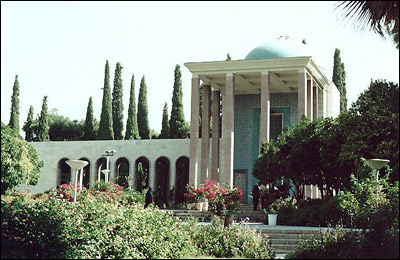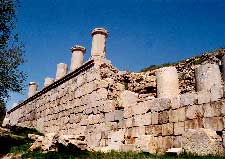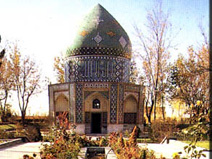|


Shiraz
to host literati event on Sadi Day

TEHRAN,
April 8 (MNA) -- Experts on Sadi will review the lifestyle of the great
poet in Shiraz on April 21, which is National Sadi Day.
The director
of the Center for the Study of Sadi said that each year specific aspects
of the poet are chosen for discussion and this year the focus will be
on his thought, character, and language.
Kurosh
Kamali-Sarvestani stated that a ceremony will be held at Sadi’s
tomb beginning with the casting of flowers on his grave. Iranian cultural
centers in other countries will also hold commemorative programs on
that day.
The center
has named each of the years between 2006 and 2016 after the great poet
and his works.
The year
2006 has been entitled “Study of Sadi Era” followed by “Sadi
Era” (2007), “Gulistan” (The Rose Garden) (2008), “Bustan”
(The Orchard) (2009), “Ghazaliyat” (Lyrics) (2010),- “Qassayed
(Odes) and Assemblies” (2011), “Study of Transcripts and Publication
of Complete Works” (2012), “Sadi, Iranian Culture, and Islamic
Culture” (2013), “Sadi, Social Issues and Contemporary Literature”
(2014), “Sadi’s Art, Aesthetics, and Popular Culture”
(2015), “Sadi in Others’ Works and Others in Sadi’s Works”
(2016).
___________________________________
Iranian
program to review music in Khayyam’s poetry

The
leader of the Sepehr musical group, Majid Kiani, will give lectures
on the musical content of Omar Khayyam’s poetry on May 17
and 18 in a program at the Niavaran Cultural Center which will
also include performances by Sepehr.
The program,
which is part of the Khayyam National Day (May 18) celebrations, will
review the use of music in Khayyam’s poetry, Kiani told the Mehr
News Agency on Saturday.
“The
first section of the concert will review the lexicology of Khayyam’s
poetry and its relationship to music, and in the second section interpretations
of several poems will be performed by the band.”
“As
many know, music is inter-related with literature and the other arts.
The poetry of Rumi, Hafez, and Sadi play major roles in traditional
Persian music. Their poetry is rhythmic and full of spirit and it is
these qualities that we endeavor to express musically”, he added.
Kiani’s
band will perform the concert in the Segah and Mahur dastgah, (a dastgah
in Iranian music is a set of notes, their features, and an associated
group of traditional melodies that constitute a basis for improvising
a performance), but other bands have performed similar concerts in other
dastgahs.
Omar Khayyam
was born on May 18, 1048 in Neyshabur, Khorasan and died on December
4, 1131 in his hometown.
This Persian
mathematician, astronomer, and poet was renowned in his own country
and at his own time for his scientific achievements, but is chiefly
known to English-speaking readers through the translation by the English
writer Edward FitszGerald of a collection of his rubaiyat (“quatrains”)
in “The Rubaiyat of Omar Khayyam” (1859).
Area
of Temple of Anahita to be Released

Temple
of Anahita
Tehran
, 19 April 2007 (CHN Foreign Desk) – The Cultural Heritage and
Tourism Department of Kangavar has taken the initial steps toward preparing
the gorund for registration of Temple of Anahita , located in Iranian
western province of Kermanshah , in list of UNESCO world heritage sites
by allocating some 150,000 US Dollars for purchasing its nearby areas.
“This
budget has been considered for buying 3 pieces of lands and 4 buildings,”
said Saeed Doustani, director of the Cultural Heritage and Tourism Department
of Kangavar. According to Doustani, some 3,000,000 US Dollars is required
to accomplish this project and expand the area of Anahita Temple by
releasing its nearby areas.
Conducting
excavations and restorations works as well as reorganizing and introducing
this historical monument are among the other programs of Cultural Heritage
and Tourism Department of Kangavar which will come into force in a near
future if the budget is provided.
Temple
of Anahita located at Kangavar in Kermanshah province was built by order
of Ardeshir II, the Achaemenid Emperor (404-359 BC). It is the most
important architectural remnant of the cult of the Persian deity Anahita
(or Nahid in Modern Persia). The remains at Kangavar illustrate a structure
that is Hellenistic in character, yet it displays Persian architectural
designs as well.
For the
first time in 1968 an Iranian team conducted some archeological excavations
in the vicinity of Anahita Temple . Later the residential areas around
the site were purchased and leveled to expand the excavation area to
allow a comprehensive plan of the Temple and its precinct. Archeological
investigations revealed that the site is about 230 meters in length
and 210 meters in width. Further excavations showed that there are a
series of pillars on the exterior part of the building along the western,
eastern, and southern parts of the Temple which were originally 35 meters
high and were consisted of three parts including shaft, plinth, and
capital.
8 seasons
of archeological excavations were conducted in this area until 1975.
Afterwards, some scattered excavations were carried out by Masoud Azarnoush,
former director of Archeology Research Center of Iran’s Cultural
Heritage and Tourism Organization, Mohammad Mehryarm, architecture and
archeologist (may his soul be blessed), and Ahmad Kabiri archeologist.
Soudabeh
Sadigh
foreigndesk@chn.ir
http://www.chnpress.com/news/?section=2&id=7092
Spanish
show displaying upshot of Bam earthquake

 TEHRAN,
April 29 (MNA) -- A photo exhibition at the Kubo de Kutxa gallery, in
the Spanish city of San Sebastian, makes visitors once again consider
the devastating consequences of the Bam earthquake of 2003. TEHRAN,
April 29 (MNA) -- A photo exhibition at the Kubo de Kutxa gallery, in
the Spanish city of San Sebastian, makes visitors once again consider
the devastating consequences of the Bam earthquake of 2003.
Isabel
Munoz, the Spanish 56-year-old photographer, who is also well known
for her innovative work with aquarelle paper, has taken the photos one
and half years after the earthquake devastated the city and its ancient
citadel, on December 26, 2003.
The
exhibition also features photos of natural and social disasters experienced
by the people of Somalia, Cambodia and China and the suffering they
underwent.
The
showcase, which was previously held in Madrid, will be running at the
Kubo de Kutxa gallery until June 24.
Iranians
Enjoyed Nanotechnology 3000 Years Ago
Apr 22, 2007
After 20 years, studies of Iranian researchers in Tchogha Zanbil and
Pasargadae historical sites led into tracing nanotechnology in these
two World Heritage Sites. According to researchers, implementing nanotechnology
in these monuments is the main reason for their 3000-year-old survival.
Researchers also believe that the special atomic combination which was
used in this technique caused some difference between the elements of
Tchogha Zanbil with its surrounding natural elements.
"We
started our researches since 20 years ago. Through the tests conducted
on some historical sites including Tchogha Zanbil and Pasargadae, we
concluded that our ancestors were one of the pioneers of nanotechnology,
who implemented this technique in their structures," said Mansour
Afrazeh, scientist researcher to CHN.
According
to Afrazeh, two nanotechnology techniques were implemented in Tchogha
Zanbil ziggurat including nanoparticles which attract harmful rays from
mobiles which are employed in structures, and nanoparticles which are
used in colors.
He
further explained that Iranians succeeded in inventing a new atomic
order in Tchogha Zanbil some 3000 years ago which was quite different
with the natural elements of its surrounding area.
The
studies further revealed that contrary to previous beliefs, what connected
the metal part of monuments in Pasargadae historical site to the stones
were not bronze joints but it was the new metal's atomic structure.
This new technique is considered very important in strengthening the
monument and its long term survival.
"Today
many developed countries such as the United States and Japan are using
this high technique for making a protective covers in an attempt to
reduce the harmful effects of mobile rays on users' brains. An apparent
similarity can be seen between this technique and what was practiced
during the first millennium BC in Tchogha Zanbil," added Afrazeh.
Regarding
the implementation of this technique in Tchogha Zanbil, Afrazeh added:
"most probably this cover was used in holy chambers and the music
halls of this monument."
Located
in Iranian southwestern province of Khuzestan, 30 kilometers south-west
of Susa, the ruins of the holy city of Elamite Kingdom, surrounded by
three huge concentric walls is found at Tchogha Zanbil. Founded 1250
BC, the city remained unfinished after it was invaded by Ashurbanipal,
as shown by the thousands of unused bricks left at the site.
The
large Tchogha Zanbil temple is one of the ancient monuments of Iran
which has been registered on UNESCO World Heritage List. The architectural
style employed in the ziggurat resembles those of Egyptian pyramids
and Mayan temples. The Tchogha Zanbil ziggurat is the only surviving
ziggurat in Iran and is one of the most important remnants of the Elamite
civilization.
Iran
Confiscates 490 Historical Coins in Isfahan
Apr 27, 2007

490 silver coins ranging in date from Sassanid dynastic era (224-651
AD) to the early Islamic period (651 AD afterwards) have been discovered
and confiscated by police department of Isfahan province from a smuggler
of historical relics and have been delivered to the Cultural Heritage
and Tourism Department of Isfahan province.
"Some
490 historical silver coins have been confiscated by police department
of Isfahan province from a smuggler of historical relics who collected
them during the recent years when he was trying to sell the coins,"
said Mohsen Javeri, head of archeology office of the Cultural Heritage
and Tourism Organization in Isfahan to CHN.
According
to Javeri, these coins ranging in date from Shapur I, the Sassanid king
(241-272 AD) to early Islamic period and reign of Abbasid caliphate
in Iran (750-821). Some of these coins have been left intact, while
some broken, chipped, and leaky coins can be also seen among them.
The
Sassanid coins had an original Persian pattern and were minted in gold,
silver and copper. Golden Sassanid Drachma was only used in foreign
trading so they are nearly rare today. Used as the main currency, silver
coins were in circulation even in neighbor regions.
During the Sassanian dynastic era, the thick silver flan of the classical
world is replaced for the first time in history of coinage by a thin,
spread flan that was later to be used universally throughout the Arab
world, in the Byzantine Empire and in medieval Europe.
After
invasion of Arabs, coinage industry did not return to its golden days
of Sassanid era. Arabian rulers began to invent their own style of coinage
by omitting the pictures from the coins and replacing it with holy verses
from the Quran and the name of rulers.
Discovery
of Oldest Industrial Site of Middle East in Pardis
View
of Pardis hill, Tehran province The most ancient industrial site of
the Middle East dating back to 7000 years ago has been discovered in
Pardis Tepe in Varamin, southern Tehran province during the closing
days of excavations.
Tehran, 29 April 2007 (CHN Foreign Desk) – Archeological excavations
in Pardis Tepe prehistoric hill resulted in identifying the most ancient
industrial site in the Middle East which dates back to 7000 years ago.
Archeologists believe that this prehistoric hill existed concurrent
with Cheshmeh Ali region in Ray city, southern Tehran and northern and
southern Sialk Tepe in Kashan.
With discovery of a large number of clay kilns and head spindles in
this industrial site, the previous theory of Dr. Smith, head of the
first archeology team in 7000-year-old historic site of Cheshmeh Ali
hill, indicating that the red clays discovered in this area are hand
made, has been rejected. This new discovery has further revealed the
secret about the technique which was implemented for making these unique
red clays some 5000 years BC.
In an interview with CHN, Hassan Fazeli Nashli, director of Archeology
Research Center and head of the excavation team in Pardis prehistoric
site, who believes that the most ancient clay wheel belongs to this
region said: “Three seasons of archeological excavations in Pardis
prehistoric site, 80 percent of which has been destroyed due to activities
of the brick factory, brought into light the unique importance of this
prehistoric site and the necessity for reorganizing its situation and
protecting it against possible damages.”
Clay kilns, clay wheels, earthenware jars, and stone necklaces are among
the most prominent discoveries in this historic site. However Fazeli
believes that the residential settlement area of this industrial site,
which could have provided archeologists some invaluable information
about people’s life during 7000 years ago in this region, has already
been demolished and changed into pieces of bricks.
According to Fazeli Nashli, although large parts of this 7000-year-old
hill has been devastated due to neglect of authorities of the brick
factory, it is not still too late to save the rest parts which have
still remained for next generations.
Pointing out the importance for delimiting Pardis region, head of archeology
team in Pardis added: “Archeology team has also succeeded in discovering
a cemetery belonging to the Iron Age when they were conducting sounding
works in the surface layer of the region, parts of which have been seriously
damaged by bulldozers of the brick factory. This discovery shows that
some unique historical evidence must have been laid beneath this region
which can provide archeologists some invaluable information about the
story of a secret civilization in this region during prehistoric periods.”
Fazeli Nashli strongly believes that the only approach for saving this
prehistoric site is changing it into a museum park, because in addition
to its unique historical value, its soil has a high potential for breeding
different kinds of trees and plants.
Mentioning that Varamin is a deprived region, Fazeli Nashli further
expressed hope that with paying more attention to Pardis historic site
and changing it into a tourism destination, the situation of the region
would be greatly improved.
“For preserving the most ancient industrial site in the Middle
East region, authorities of Iran’s Cultural Heritage and Tourism
Organization (ICHTO), municipality and city council of Varamin should
cooperate to save it with changing it into a park museum. The time has
come to bring archeo-anthropology science into force through using prehistoric
and historic sites as a bed for cultural development and providing public
facilities for the people of region,” added head of Archeology
Research Center.
Pardis historical hill belongs to the fifth and sixth millennia BC and
the remains of a Parthian fortress (248-224 AD) can be seen on the upper
layer on this historical hill. Cultural heritage experts strongly believe
that the area has the potential to be turned into a museum park.
Last summer an international team consisted of experts from Lister University
of Edinburgh, and University of Tehran conducted some excavations in
the region which led into some valuable archeological discoveries.
Soudabeh Sadigh
foreigndesk@chn.ir
Commemoration
of Sufi Hagiographer Celebrated in Nishapur

Attar’s
tomb in Nishapur Commemoration of Farid al-Din Attar held in Nishapur,
Khorasan province with message of Iran’s Minister of Culture and
Islamic Guidance this morning.
Tehran, 14 April 2007 (CHN Foreign Desk) --
Farid al-Din Attar, Persian great poet, was the principal Muslim mystical
poet and writer in the second half of the 12th century. Attar works
were the inspiration of Rumi and many other mystic poets. Attar along
with Sanaie, were two of the greatest influences on Rumi in his Sufi
views. Rumi has mentioned both of them with the highest esteem several
times in his poetry. Jalal al-Din Rumi praises Attar as such: “Attar
roamed the seven cities of love, We are still just in one alley”.
Attar is best known for his often-translated masterpiece Mantiq al-tayr,
literally means, The Conference of the Birds, is still considered to
be the best example of Sufism poetry in Persian language after Rumi’s
verses. Distinguished for his provocative and radical theology of love,
many lines of Attar’s poems and lyrics are cited independently
as maxims in their own right. These paradoxical statements are still
known by heart and sung by minstrels throughout Iran, Afghanistan, Tajikistan
and wherever Persian is spoken or understood, such as in the lands of
the Indo-Pakistani Subcontinent.
Attar composed at least 45,000 couplets and many brilliant prose works
in six important works of poetry and one major prose work. His great
prose work comprises the monumental compendium in Persian of biographies
of famous Sufis, is called Tadhkirat al-awliya, or Memoirs of the Saints.
While Asrar Nameh, or the Book of Mysteries which strings together a
series of unconnected episodic stories, is known Attar’s least
known poems, Mantiq al-tayr or the Conference of Birds, is known as
his most famous epic poem, which is consecrated to the tale of the spiritual
quest of thirty birds to find their supreme sovereign, the Simurgh.
This work was modeled on the Treatise on the Birds composed half a century
earlier by another Sufi master, Ahmad Ghazali (d. 1126 CE), founder
of the ‘school of love’ in Sufism. This epic masterpiece (to
which five essays in chapter two of the present volume are devoted)
has also enjoyed several musical and theatrical adaptations in the West,
while its stories are common subjects of illustration in Persian miniature
painting.
Attar’s Book of Adversity (Musibat-nameh) recounts the Sufi path
in other terms, following the voyage of the contemplative wayfarer or
‘Pilgrim of Thought’ (salik-i fikrat) through the mineral,
vegetable, animal, human, and angelic realms.
Attar’s Divine Book (Ilahi-nameh) relates the story of a king who
asks his six sons what they most desire. They all ask for worldly things,
and the king exposes their vanity in a series of anecdotes. The Book
of Selections (Mukhtar-namah) is a collection of over 2,000 quatrains
(ruba‘i) arranged in 50 chapters according to various mystical
themes, and his Collected Poems (Diwan) contains some 10,000 couplets
which are notable for their depiction of visionary landscapes and heart-rending
evocations of the agonies and ecstasies of the via mystic. These poems
are notable not only for their thematic unity, with usually just one
mystical idea, or a series of related concepts from first verse to last
line being elaborated progressively, but also for their esoteric hermeticism
and unconventional religious values. The attribution of the Book of
Khusraw (Khusraw-namah, a romance of the love between a Byzantine princess
and a Persian prince, with almost no mystical content) to the poet has
been rejected, on convincing stylistic, linguistic and historical grounds,
as spurious.
Attar’s works had such an impact on both the Sufi community and
the literate public at large that his fame soared soon after his death.
He became rapidly imitated, so that today there are some twenty-three
works falsely attributed to ‘Attar, proven by modern scholars to
be spurious or of doubtful authenticity. If we take merely the works
that are unquestionably his, comprising a good 45,000 lines, the achievement
is monumental.
However, the most important aspect of Attar’s thought lies in the
fact that all of his works are devoted to Sufism (tasawuf) and throughout
all of his genuine collected works, there does not exist even one single
verse without a mystical coloring; in fact, Attar dedicated his entire
literary existence to Sufism. The wide range of papers included in this
collection is itself testimony to the stature of Attar as one of the
greatest figures in the glorious tradition of Persian Sufi poetry. Bringing
together for the first time the work of both senior and younger scholars
from three continents, the volume offers a stimulating overview of Attar
and his extraordinarily varied literary creations from a whole series
of different viewpoints, which build on the findings of earlier scholarship
to offer many novel perspectives.
In 2002 an international conference entitled Farid al Din Attar and
the Persian Sufi Tradition was held by the Iran Heritage Foundation
in collaboration with the Center of Near and Middle Eastern Studies
at the School of Oriental and African Studies (SOAS), and the University
of London. The conference, which was convened by Dr. Leonard Lewisohn,
author, translator and researcher in the area of Islamic studies and
a specialist in Persian language and Sufi literature, and Christopher
Shackle, Professor of Modern Language of South Asia at SOAS at University
of London was the centerpiece of a number of musical, poetic and artistic
events in London to celebrate Persian mysticism and the literary contributions
of Farid al-Din Attar.
Farid al-Din Attar was born in Nishapur, Iranian Khorasan province.
There is disagreement over the exact dates of his birth and death but
several sources confirm that he lived almost 100 years. Different stories
are told about the death of Attar. One common story is as follow: He
was captured by a Mongol. One day someone came along and offered a thousand
pieces of silver for him. Attar told the Mongol not to sell him for
that price since the price was not right. The Mongol accepted Attar’s
words and did not sell him. Later someone else comes along and offers
a sack of straw for him. Attar counsels the Mongol to sell him because
that is how much he is worth. The Mongol soldier becomes very angry
and cuts off Attar’s head so he died to teach a lesson.
Attar’s tomb in Nishapur, attracted a large number of tourists
every year who pay visit to Nishapur historic city to pay their attribute
to this great Persian poet and writer.
Every year, concurrent with commemoration day of Farid al- Din Attar
Neishaburi on 14th of April, a special ceremony is held in city of Neishabur,
Khorasan Razavi province with attendance of intellectuals, academic
members, authors, students, etc.
Ladan M. Sadeghioon
foreigndesk@chn.ir
Source
are : Cultural Heritage/Mehr/ws-iran
|




 TEHRAN,
April 29 (MNA) -- A photo exhibition at the Kubo de Kutxa gallery, in
the Spanish city of San Sebastian, makes visitors once again consider
the devastating consequences of the Bam earthquake of 2003.
TEHRAN,
April 29 (MNA) -- A photo exhibition at the Kubo de Kutxa gallery, in
the Spanish city of San Sebastian, makes visitors once again consider
the devastating consequences of the Bam earthquake of 2003. 
